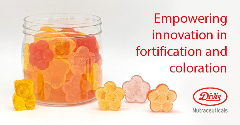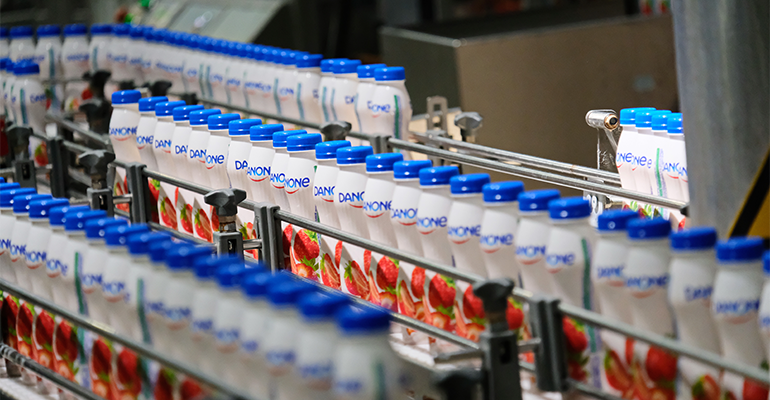News
Exploring the path to replicating breast milk's magic in infant formula
17 Nov 2023
While breast milk is often hailed as nature's gold standard for infant nutrition, it’s not always readily available. Enter infant formula enriched with human milk oligosaccharides (HMOs), a game-changing product that seek to mirror the composition of breast milk.
As part of the Vitafoods Insights July 2023 webinar on infant and children's health, Dr. Regina Karim, global senior science manager at H&H Group, a global health and nutrition company, discussed H&H’s research on the health benefits of HMOs.

HMOs as building blocks to a healthy gut
Karim highlighted the first 1000 days of a child’s life as a critical period for establishing optimal microbiome growth and development, referring to this period as “a window of opportunity for a healthy microbiota”. She noted that human milk oligosaccharides (HMOs), which are naturally occurring milk sugars in human breast milk, play a significant role in establishing a healthy microbiome.
Karim emphasised that HMOs, despite being non-digestible carbohydrates with no direct nutritional value for infants, act as prebiotics, specifically supporting the growth of beneficial bacteria. They are primarily absorbed by B. Infantis, a 'friendly' strain dominant in an infant's gut.
Karim also stressed that HMOs play a crucial role in strengthening the gut barrier function, acting as decoy receptors that prevent pathogens from attaching to the gut. Instead, pathogens get trapped by HMOs and are flushed away, providing a crucial immunity protection function.
Translating the benefits of HMOs to formula
Despite the well-established benefits of HMOs in breast milk, practical challenges may hinder breastfeeding such as maternal health, work-related commitments, or infant health conditions. In such scenarios, infant formulas step in to provide essential nutrition to babies. Historically, these formulas lacked the bioactive components present in breast milk, particularly HMOs.
In recent years, HMOs have made a significant impact by becoming key ingredients in infant formulas, making their debut in the European market back in 2018 and steadily gaining popularity since. Regulatory bodies such as the US Food and Drug Administration (FDA) and European Food Safety Authority (EFSA) have given the green light to specific HMOs, including 2′-fucosyllactose (2′-FL) and Lacto‐N‐neotetraose (LNnT), to be incorporated into infant formulas.
 © AdobeStock/Supachai
© AdobeStock/Supachai
Further research is necessary to comprehensively evaluate the advantages and disadvantages of introducing individual HMOs into formulas compared to natural breast milk. Encouragingly, a 2023 review, conducted by the HMO science team from Chr. Hansen and published in Nutrients, analysed 26 clinical studies involving the supplementation of manufactured HMOs. These studies consistently affirmed the safety and tolerability of HMO supplementation. Notably, when exclusively examining infant studies, the researchers reported improvements in gut microbiome and immune markers closely resembling the outcomes observed in breastfed infants.
Balancing affordability in the growing global HMO market
Balancing the evident advantages of HMOs with affordability is a pivotal concern for the industry. The substantial costs associated with incorporating HMOs into infant formula can pose accessibility challenges, particularly in regions experiencing high inflation. Recent Mintel research on the future of baby milk and food, published in October of this year, indicates 64% of UK consumers with children aged four and under are feeling the impact of rising food and drink prices. To address this, it was suggested that formulas emphasising essential nutrients for babies at an affordable price could alleviate parents' concerns regarding the rising costs of infant milk formula.
In tandem with these challenges, the global HMO market is experiencing growth. Its value has surged from US $125.9 million in 2020 to a projected $332.6 m by 2028, as reported by Allied Market Research. As this market expands, some companies are exploring opportunities beyond infant nutrition. One such example is the US-based startup Layer Origin Nutrition, which recognised the potential benefits of HMOs for products targeting adults. In 2021, it launched seven HMO-based products, signalling a growing trend towards diversifying the use of HMOs beyond infant nutrition.
The industry's challenge lies in striking a delicate balance: creating products that harness the potential benefits of HMOs while ensuring they remain affordable.
Related news

Empowering innovation in fortification and colouration
13 Nov 2025
Divi’s Nutraceuticals offers a large portfolio of innovative, high-quality ingredients for foods, beverages, and supplements, with bespoke solutions and expert support for product success.
Read more
Danone highlights digestive health as potential ‘tipping point’ for food industry
13 Nov 2025
Danone is betting on a food industry “tipping point” that will bloat the market for healthy products, particularly those related to gut health.
Read more
Standing Ovation and Bel scale up casein production from dairy co-products
11 Nov 2025
Foodtech company Standing Ovation has partnered with cheese specialist Bel Group to manufacture dairy serums for industrial-scale casein production via precision fermentation.
Read more
New UPF standard hoped to offer consumers ‘coherence and clarity’
10 Nov 2025
Ingredients companies are being urged to enter “a new era of partnership and innovation” following the launch of the industry’s first non-UPF verification scheme.
Read more
Whistleblowers accuse UK meat industry of promoting cheap, unsustainable supply
7 Nov 2025
An anonymous group of industry insiders has accused the UK’s biggest food companies of systematically driving down meat quality and welfare standards.
Read more
Cottage cheese makes a comeback as consumers call for cleaner labels
6 Nov 2025
From ice cream to dips and ready meals, cottage cheese is experiencing a renaissance as a high-protein, clean ingredient for health-conscious consumers.
Read more
Bord Bia presents Irish dairy ingredient suppliers at Fi Europe
6 Nov 2025
Dairygold Co-operative Society, The Carbery Group, and Ornua Co-operative: Meet with sustainable producers of Irish dairy ingredients at Food ingredients Europe 2025, Hall 7.2 Stand M18.
Read more
Faravelli at Fi Europe: Showcasing FARA® functional solutions for food and nutra
28 Oct 2025
At Fi Europe 2025 in Paris (stand 72M39), Faravelli showcases FARA® Customized Functional Solutions and a wide ingredient portfolio for food and nutra – delivering quality, innovation, and expertise.
Read more
Agrigum Redefined FIBER
27 Oct 2025
Agrigum has transformed gum acacia into a natural, science-backed fibre that supports gut health, sustainability, and innovation across global food and nutrition applications.
Read more
Expanding boundaries in food & beverage innovation
23 Oct 2025
IMCD and FrieslandCampina Professional expand partnership to deliver Kievit® across EMEA, enabling brands to enhance quality and accelerate time-to-market for tomorrow’s food & beverage creations.
Read more